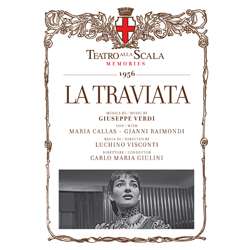|
Back
07/07/2012
Giuseppe Verdi: La traviata
Maria Callas (Violetta Valéry), Gianni Raimondi (Alfredo Germont), Ettore Bastianini (Giorgio Germont), Silvana Zanolli (Flora Bervoix), Luisa Mandelli (Annina), Giuseppe Zampieri (Gastone), Silvio Maionica (Dr. Grenvil), Arturo La Porta (Baron Douphol), Dario Caselli (Marchese d’Obigny), The Chorus and Orchestra of Teatro alla Scala, Milan, Carlo Maria Giulini (Conductor)
Recorded Live at Teatro alla Scala, Milan (19 January, 1956) – 118’51
La Scala Memories 3 – Book with essays and translations in Italian and English

It seems as though the search is never complete. For devotees of Maria Callas the fact that there is no wholly satisfactory complete recording of the soprano in her iconic role of Violetta Valéry remains a significant regret. Safe to say, however, if it hasn’t been issued by now, there never will be such a thing. This recording from La Scala Memories is an archive of the opening night performance from 1956, a year after the premiere of the triumphant Visconti production that paired Callas with Giuseppe di Stefano. The recording of the premiere from 1955 has long been a favorite of collectors who prized it for the sheer power of Callas’ and Di Stefano’s performances, despite the subpar quality of the recorded sound. The problem with this latest issue from just a year later, is that, despite a stunningly beautiful and thoughtful presentation, the recorded sound is quite unsatisfactory and substantially worse than other issues.
There is almost no presence and authority to the sound. It often sounds more distant than the famous 1955 version and, even worse, suffers from what I imagine is either damage to the tapes or careless editing. Inconveniences such as tape hiss and distortion, both of which there are ample, are to be expected in recordings like this. The chorus often overwhelms the equipment in the first act party scene which creates a rather unpleasant sound and there is an often annoying “fuzz” around the upper strings or voices that muddles the quality. When “tutti,” the sound is partly unintelligible and harsh. I compared the “Brindisi” from this recording to the 1955 recording and the difference is very noticeable. It is not that the 1955 recording doesn’t have issues with distortion and hiss, just that they are significantly reduced. The purity and character of sound that EMI managed in the 1955 restoration are much more desirable. In fact, the substantial book of information that accompanies this new issue doesn’t seem to provide any details on recording or restoration. Thankfully, the second half of the recording is noticeably improved for whatever reason with less ambient noise and a higher fidelity, but on the whole, it is too late.
As previously mentioned, there appears to be some damage to the tapes or editing issues. The most notable of which is at the end of the seventh scene of Act II. When the elder Germont sings a thrilling “Che dici? Ah, ferma!” his “Ah” is virtually cut off from the recording entirely. The same thing happens in Act I. The “È” of Violetta’s first “È strano!” is absent. Another disturbing issue is the variability of the volume levels. For example, in the last act, third scene, in the tender exchange between Annina and Violetta, the volume inexplicably gets much louder and changes quality (Disc 2, track 11).
As for the performance, the standout is the young Gianni Raimondi who showed a youthful yet powerful sound in what was his La Scala premiere. It is clear to see why a promising career awaited him; however, Maria Callas’ performance will undoubtedly be the draw here. Despite some annoying sound issues during her Act I aria, there is some outrageously masterful singing and drama as one would expect. Her voice retains power and vitality in this recording and her dramatic instincts are strikingly vivid. Bastianini’s Germont is stern, yet not a wooden caricature, with a robust, golden baritone. Giulini’s tempos are brisk for the most part, with brief formulaic pauses between scenes. On the whole, the performance is exciting, with substantial electricity but lacking in the seeming spontaneity of the previous year’s affair.
The most impressive and attractive component of this issue is the more than 100-page book that holds the CDs. There are two substantial essays, a performance history of La Traviata at La Scala, and a full libretto and synopsis. Even more, there are dozens of gorgeous black and white photos of the performers and production. The presentation is outstanding and may alone be worth the price for many.
Perhaps all of the technical issues were unavoidable. After all, the source of this recording is over half a century old and it is clearly presented as an homage to the great Theater and Verdi’s timeless work. The presentation and presence of La Divina will make it attractive to some, but as a recording, it is only recommendable as a supplement to the other live Callas recordings of La traviata already published.
Matthew Richard Martinez
|